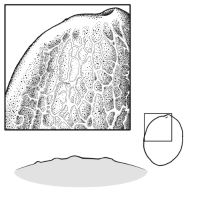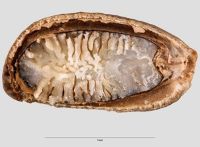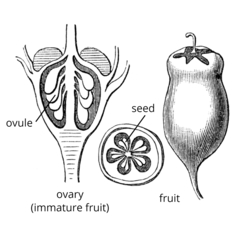Content is from Kirkbride et al. 2006Kirkbride et al. 2006:
Kirkbride JH, Jr, Gunn CR, and Dallwitz MJ. 2006. Family guide for fruits and seeds, vers. 1.0. Accessed September 2020-January 2022. URL: https://nt.ars-grin.gov/seedsfruits/keys/frsdfam/index.cfm ., without modification.
Updates are forthcoming.
Fruits: Pistil(s) compound; 1; 1-pistillate; with carpels united. Fruit pericarpium; simple; drupedrupe:
(indehiscent drupe) a fleshy, indehiscent fruit with one more hard pits enclosing seeds, derived from single, superior, simple or compound ovary; (dehiscent drupe) a fruit with a dry or fibrous to fleshy or leathery outer husk that early to tardily breaks apart (or opens), exposing one or more nutlike pits enclosing the seeds (exocarpexocarp:
(exocarpexocarp:
outer layer of fruit wall or pericarp, if divided into layers; note here used synonymously with epicarp occasionally splitting), or nuculanium, or capsulecapsule:
occasionally splitting), or nuculanium, or capsulecapsule:
a dry, dehiscent fruit derived from a compound ovary ; loculicidalloculicidal:
; loculicidalloculicidal:
type of capsular dehiscence, opening longitudinally through the locules (compare septicidal)
 capsulecapsule:
capsulecapsule:
a dry, dehiscent fruit derived from a compound ovary ; capsulecapsule:
; capsulecapsule:
a dry, dehiscent fruit derived from a compound ovary not inflated; capsulecapsule:
not inflated; capsulecapsule:
a dry, dehiscent fruit derived from a compound ovary without operculumoperculum:
without operculumoperculum:
a dehiscent cap (or lid) of a seed or fruit that opens during germination or dehiscence ; without persistent central column; not within accessory organ(s); more than 1 but less than 10-seeded (assumed); 1–8-seeded (assumed); from 1–5 cm long; 2–4 cm long; with 2(–4)-carpellate; with carpels united; with carpels remaining united at maturity; with carpels not radiating at maturity; without sterilesterile:
; without persistent central column; not within accessory organ(s); more than 1 but less than 10-seeded (assumed); 1–8-seeded (assumed); from 1–5 cm long; 2–4 cm long; with 2(–4)-carpellate; with carpels united; with carpels remaining united at maturity; with carpels not radiating at maturity; without sterilesterile:
lacking male and/or female reproductive parts; also, not producing fruit or seed
 carpels; apexapex:
carpels; apexapex:
the point farthest from the point of attachment, or the "tip" of an organ not beaked; indehiscentindehiscent:
not beaked; indehiscentindehiscent:
not opening on its own, as in a fruit
 , or dehiscentdehiscent:
, or dehiscentdehiscent:
(v. dehisce) splitting open at maturity to release contents (of a fruit) . Dehiscentdehiscent:
. Dehiscentdehiscent:
(v. dehisce) splitting open at maturity to release contents (of a fruit) unit endocarp(s). Dehiscentdehiscent:
unit endocarp(s). Dehiscentdehiscent:
(v. dehisce) splitting open at maturity to release contents (of a fruit) passively; without replumreplum:
passively; without replumreplum:
the rim, formed by the persistent placentas, and connected by a false septum in Brassicaceae fruits. The fruit valves are attached to this rim and separate from it in dehiscent fruits.
. Epicarpepicarp:
outer layer of fruit wall or pericarp, if divided into layers; note here used synonymously with exocarp yellow, or orange; durable; coriaceouscoriaceous:
yellow, or orange; durable; coriaceouscoriaceous:
texture—leathery
; not glabrousglabrous:
without hairs
(with hairs), or glabrousglabrous:
without hairs
; hairs long; hairs dense, or scattered, or widely scattered; hairs not glandularglandular:
surface relief—covered with small, raised secretory glands, regular or irregularly shaped, translucent or opaque, and maybe distinctly colored ; without armature; smooth (assumed); without wing(s); without apicalapical:
; without armature; smooth (assumed); without wing(s); without apicalapical:
at or pertaining to the end of the seed or fruit distal from its point of attachment (i.e., base)
respiratory hole. Mesocarpmesocarp:
the middle layer of the pericarp, if divided into layers present; fleshy, or thin; composed of 1 unified layer; without lactiform cavity system; & endocarpendocarp:
present; fleshy, or thin; composed of 1 unified layer; without lactiform cavity system; & endocarpendocarp:
the inner layer of the pericarp, if divided into layers sharply differentiated. Endocarpendocarp:
sharply differentiated. Endocarpendocarp:
the inner layer of the pericarp, if divided into layers present; not separating from exocarpexocarp:
present; not separating from exocarpexocarp:
outer layer of fruit wall or pericarp, if divided into layers; note here used synonymously with epicarp ; coriaceouscoriaceous:
; coriaceouscoriaceous:
texture—leathery
, or bonybony:
very hard and rather brittle, like bone
; not splitting into 1-seeded pyrenespyrene:
the hard inner portion of a drupe, consisting of a bony endocarp and an enclosed seed
, or splitting into 1-seeded pyrenes; stone unilocular, or plurilocular; stone 1(–3)-loculate; smooth, or not smooth (rugoserugose:
wrinkled ); without wing; without operculumoperculum:
); without wing; without operculumoperculum:
a dehiscent cap (or lid) of a seed or fruit that opens during germination or dehiscence ; without secretory cavities; without mechanism for seedling escape; without grooves; without longitudinallongitudinal:
; without secretory cavities; without mechanism for seedling escape; without grooves; without longitudinallongitudinal:
of or relating to length or the lengthwise dimension
ridges. Funiculusfuniculus:
(alt. funicle) stalk connecting the ovule (later seed) to the ovary (later fruit) placenta short; short without seed bearing hookswith hooks:
short; short without seed bearing hookswith hooks:
bristles or spines with curved or backwards pointing tips, or with secondary bristles along their length (retinacula); not persisting in fruit after seed shed.
(retinacula); not persisting in fruit after seed shed.
Seeds: Arilaril:
(broad sense) appendicular structure that wholly or partly envelops a seed and is produced from or a modification of the funicle, raphe, or outer integument; usually fleshy or pulpy, sometimes spongy or tufted-capillate, often brightly colored present, or absent; an arillike structure. Arillike structure falling with seed a carunclecaruncle:
present, or absent; an arillike structure. Arillike structure falling with seed a carunclecaruncle:
a localized outgrowth of the seed coat near the hilum of the seed; it functions as an elaiosome . Seed larger than minute; 10 to less than 25 mm long; 15–20 mm long; ovateovate:
. Seed larger than minute; 10 to less than 25 mm long; 15–20 mm long; ovateovate:
2D shape—egg-shaped in outline, widest point is towards one end of the organ, the other end tapers gradually, attachment at or near the broad end (compare obovate, ovoid) and straight; in transection compressedcompressed:
and straight; in transection compressedcompressed:
flattened; in grasses, used to denote compression (not necessarily flattened) either laterally or dorsiventrally
; not bowl shaped; not nutlike; without winglike beakbeak:
a usually firm, terminal appendage, sometimes tapered ; without caudatecaudate:
; without caudatecaudate:
tapering to a long, tail-like appendage appendage(s); at maturity without food reserves, or without apparent food reserves, or with food reserves; with endosperm; without canavanine. Sarcotestasarcotesta:
appendage(s); at maturity without food reserves, or without apparent food reserves, or with food reserves; with endosperm; without canavanine. Sarcotestasarcotesta:
pulpy or fleshy outer layer of the seed coat, simulates aril absent. Testatesta:
absent. Testatesta:
seed coat
 present; without markedly different marginalmarginal:
present; without markedly different marginalmarginal:
at, on, or close to the margin or border
tissue; without fleshy or leatheryleathery:
texture—moderately thick, tough, and very pliable
layer over hard layer; loose; dulldull:
reflecting only a low proportion of incident light, with no apparent sheen , or shinyshiny:
, or shinyshiny:
uniformly reflecting a high proportion of incident light at all angles ; surface unsmooth, or smooth; surface with merged raised features; surface reticulatereticulate:
; surface unsmooth, or smooth; surface with merged raised features; surface reticulatereticulate:
surface relief—netted, raised walls or concave grooves forming a net-like surface pattern with flat, concave, or convex interspaces , or veinedveined:
, or veinedveined:
surface relief—lines that intersect in a vein pattern that is flush or slightly raised from the surface ; without crease or line separating cotyledons from hypocotyl-radicle; without notch along margin where cotyledons from hypocotyl-radicle tip approach each other; without glands; without bristles; glabrousglabrous:
; without crease or line separating cotyledons from hypocotyl-radicle; without notch along margin where cotyledons from hypocotyl-radicle tip approach each other; without glands; without bristles; glabrousglabrous:
without hairs
; without wings; without collar; without operculumoperculum:
a dehiscent cap (or lid) of a seed or fruit that opens during germination or dehiscence ; colored, or transparent; monochrome; light to dark brown (all shades); thin, or membranousmembranous:
; colored, or transparent; monochrome; light to dark brown (all shades); thin, or membranousmembranous:
texture—extremely thin, pliable, and fairly tough
; not becoming mucilaginousmucilaginous:
resembling mucilage; moist and sticky
when wetted; surrounding embryo. Hilumhilum:
on seeds, the scar indicating where the funiculus was attached; on grass caryopses, the scar visible on the outer fruit surface revealing where the seed is attached on the inner fruit wall surface; or in Asteraceae cypselae, the scar visible on the outer fruit wall revealing where the fruit was attached to the receptacle larger than punctatepunctate:
larger than punctatepunctate:
surface relief—dotted with pits or with translucent, sunken glands or with colored dots, similar to pitted ; "broad". Endosperm trace (trace between cotyledons); without fatty acid containing cyclopropene; without apicalapical:
; "broad". Endosperm trace (trace between cotyledons); without fatty acid containing cyclopropene; without apicalapical:
at or pertaining to the end of the seed or fruit distal from its point of attachment (i.e., base)
lobes; without chlorophyll; without isodiametric faceted surface; without odor. Embryo differentiated from food reserve; well developed; 1 per seed; completely filling testatesta:
seed coat
 (no food reserve); at one end of seed not extending into a depression or cup; foliatefoliate:
(no food reserve); at one end of seed not extending into a depression or cup; foliatefoliate:
appearing leaf-like
; with investinginvesting:
(of embryo) embryo is nearly or completely filling seed coat, straight, and axile and centric with spatulate cotyledons and covering the stalk for at least half its length; (of cotyledons) cotyledons spatulate and covering the stalk for at least half its length
cotyledons; straight; with cotyledons abruptly connected to hypocotyl-radicle; without coleorhiza; without simmondsin; with cotyledons containing oils; without stomata; not green, or green; with 2 or more cotyledons. Cotyledons 2; well developed; 0.97 times length of embryo; somewhat to significantly wider than hypocotyl-radicle; 12 times wider than hypocotyl-radicle; partially concealing hypocotyl-radicle; not foliaceous; massive; ruminateruminate:
testa or seed coat folded into the endosperm , or smooth (& occasionally with hairs along lower margins); with apicesapex:
, or smooth (& occasionally with hairs along lower margins); with apicesapex:
the point farthest from the point of attachment, or the "tip" of an organ entire; with margins separate; basally entire; equal in size; not punctatepunctate:
entire; with margins separate; basally entire; equal in size; not punctatepunctate:
surface relief—dotted with pits or with translucent, sunken glands or with colored dots, similar to pitted dotted. Hypocotyl-radicle moderately developed (& pubescentpubescent:
dotted. Hypocotyl-radicle moderately developed (& pubescentpubescent:
surface relief—bearing hairs
); straight; not thickened. Plumule with a short stalk.
Literature specific to this family: Boesewinkel, F.D. & F. Bouman. 1980. Development of ovuleovule:
organ that contains the egg and after fertilization, becomes the seed and seed-coat of Dichapetalum mombuttense Engl. with notes on other species. Acta Bot. Neerl. 29:103–115; Prance, G.T. 1977. Two new species for the flora of Panama. Brittonia 29:154–158; Bretler, F.J. 1970. The African Dichapetalaceae II: Three new species from West Africa. Acta. Bot. Neerl. 19:7–15.
and seed-coat of Dichapetalum mombuttense Engl. with notes on other species. Acta Bot. Neerl. 29:103–115; Prance, G.T. 1977. Two new species for the flora of Panama. Brittonia 29:154–158; Bretler, F.J. 1970. The African Dichapetalaceae II: Three new species from West Africa. Acta. Bot. Neerl. 19:7–15.
General references: Cronquist, A. 1981. An integrated system of classification of flowering plants, 1,262 p. Columbia University Press, New York, Engler, A. & K. Prantl. 1924 and onward. Die Natürlichen Pflanzenfamilimien. W. Engelman, Leipzig, Goldberg, A. 1986 (dicots) & 1989 (monocots). Classification, evolution, and phylogeny of the familes of Dicotyledons. Smithsonian Contr. Bot. 58 for dicots (314 pp.) & 71 for monocots (74 pp.). [Goldberg's illustrations are reproduced from older publications and these should be consulted], Gunn, C.R. & C.A. Ritchie. 1988. Identification of disseminulesdisseminule:
detachable plant part capable of being disseminated and of propagating, commonly a seed or fruit
listed in the Federal Noxious Weed Act. Techn. Bull. U.S.D.A. 1719:1–313, Gunn, C.R., J.H. Wiersema, C.A. Ritchie, & J.H. Kirkbride, Jr. 1992 & amendments. Families and genera of Spermatophytes recognized by the Agricultural Research Service. Techn. Bull. U.S.D.A. 1796:1–500, Mabberley, D.J. 1987. The plant-book, 706 p. Cambridge University Press, Cambridge, Roosmalen, M.G.M. van. 1985. Fruits of the Guianan flora, 483 pp. Institute of Systematic Botany, Wageningen Agricultural University. Drukkerij Veenman B.V., Wageningen, and Spjut, R.W. 1994. A systematic treatment of fruit types. Mem. New York Bot. Gard. 70:1–182.